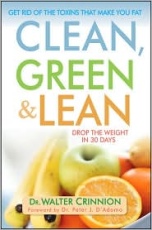 Excerpt
from Clean, Green, and Lean: Get Rid of the Toxins That Make You Fat
Excerpt
from Clean, Green, and Lean: Get Rid of the Toxins That Make You Fat
by Dr. Walter Crinnion Forward by Dr. Peter J. D'Adamo
An Apple a Day Won't Keep the Doctor Away -- Unless It's Organic
The EWG recently studied extensive USDA and FDA testing that measured pesticide residues in produce and then ranked the most commonly eaten fruits and vegetables in this country on a scale from most toxic to most consistently clean. I strongly encourage you to take the list of the "dirty dozen" to the grocery store with you. If your produce manager isn't stocking organic versions of all of the following, you may want to enlighten him or her.The Dirty Dozen (highest in pesticides)
Apples
Bell peppers
Carrots
Celery
Cherries
Grapes (imported)
Kale
Lettuce
Nectarines
Peaches
Pears
Strawberries
What a conundrum. We know we're supposed to eat our fruit and vegetables because they have crucial nutrients that other foods don't, but here on the dirty dozen list, some of our favorites are covered with the most toxic agricultural chemicals out there. So do yourself and your family a favor and buy these twelve only if they're organically grown. And eat a good variety, because they all contain different antioxidants.
If you can't find organic and you're determined to eat the forbidden fruit (or vegetable), the nonorganic varieties can sometimes be made less toxic by peeling them (great for apples and potatoes, not so great for lettuce and strawberries). Their toxic content can be further reduced by soaking and scrubbing them in a tub of 10 percent vinegar (also not so great for lettuce and strawberries). And regardless of whether it's organic or nonorganic, wash it. Whatever it is that's keeping the bugs at bay at the supermarket is also surely settling on the surface of the produce.
Avoiding the nonorganic versions altogether is the best strategy, though. A study in Seattle showed that when the most toxic fruits and vegetables were removed from preschoolers' diets (along with almonds) and replaced with organic varieties, the kids' pesticide levels went way down. Their levels of key pesticides dropped to essentially zero and stayed undetectable until they started eating conventional foods again.
So now that you know what not to eat, what should you eat? You can start with the flip side of the dirty dozen: the clean dozen. Not all nonorganic versions of fruits and vegetables pack a toxic punch, and these twelve have virtually no pesticide levels. These are the nonorganic varieties you can buy without lying awake at night regretting that you've made your toxic burden worse.
The Clean Dozen (lowest in pesticides)
Asparagus
Avocados
Cabbage
Eggplant
Kiwis
Mangoes
Onions
Papayas
Pineapples
Sweet corn
Sweet peas
Watermelon
While it would obviously be best to buy organic varieties of all of our foods, when it comes to these twelve fruits and vegetables, you can feel safe buying the commercial varieties. So unless you have a big grocery budget that allows you to buy nothing but organic foods, use your organic allowance to buy organic apples instead of organic broccoli or bananas.
|
Detoxing Nonorganic Produce
If you can't find organic varieties, use these methods to reduce your toxic exposure:
|
The above is an excerpt from the book Clean, Green, and Lean: Get Rid of the Toxins That Make You Fat by Dr. Walter Crinnion. The above excerpt is a digitally scanned reproduction of text from print. Although this excerpt has been proofread, occasional errors may appear due to the scanning process. Please refer to the finished book for accuracy.
Reprinted by permission of the publisher, John Wiley & Sons, Inc., from Clean, Green & Lean, by Walter Crinnion. Copyright © 2010 by Walter Crinnion.
